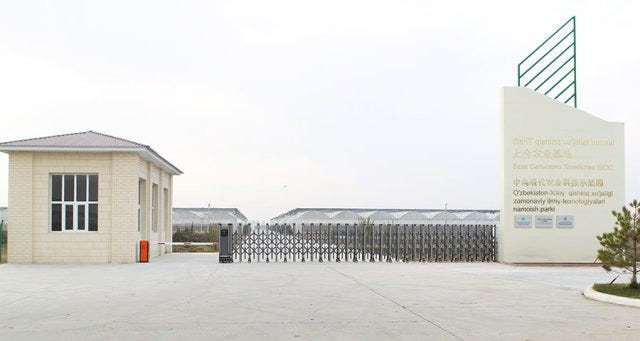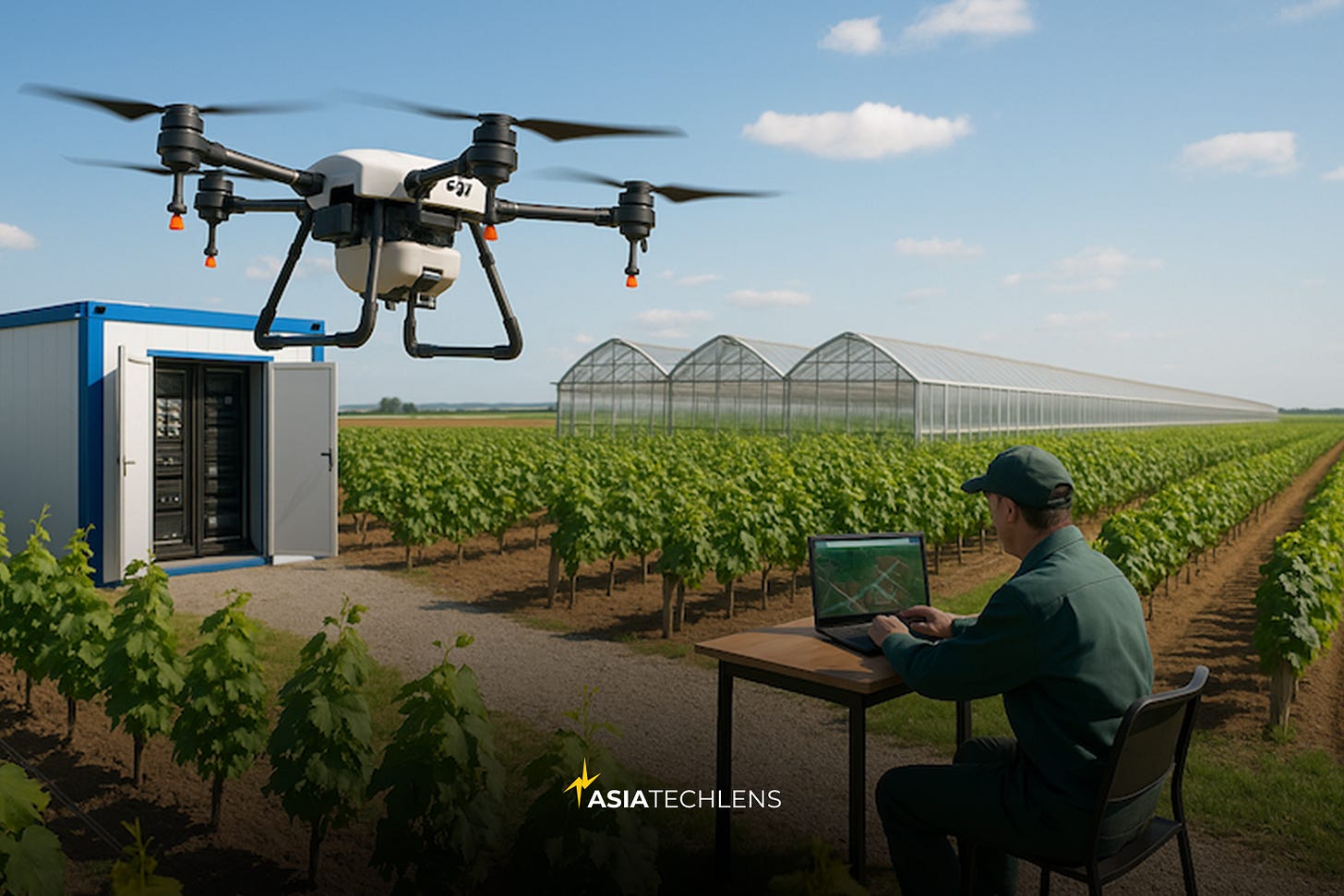Seeds of Influence: China's Smart Farms Reshape Central Asia's Harvest
Billions in Chinese agri-tech promise drought-proof yields—but risk deep tech dependency. Will Central Asia reap independence or sow away sovereignty?
Inside the Smart Farm
In Syrdarya, a low-slung greenhouse hums with sensors and cameras. Its soil data feeds a Chinese AI model that decides when to water and what to plant next. The promise is higher yields in a hotter climate. The risk is a farm system that runs on someone else’s code, a new kind of dependence taking root across Central Asia.
China’s push into smart farming in Central Asia is more than a tech transfer; it’s a strategic play in food security and regional influence.
In Uzbekistan’s region of Syrdarya, a China–Uzbekistan demonstration park is running greenhouse and drip-irrigation trials with Chinese partners. The site is testing Chinese crop varieties in controlled plots.
Under the relentless sun, rows of greenhouses shelter climate-controlled trials, while automated drip lines feed grapevines and oilseed sunflowers. Uzbek farmers in wide-brimmed hats walk the rows with Chinese agronomists, inspecting hybrids that promise double yields in arid soil.
The operator, Yangling Modern Agriculture International Cooperation, lists inputs from Chinese research institutes and companies, including photovoltaic irrigation and biological pest control; evidence that the park is testing a full ecosystem, not just greenhouses.
Recent cooperation is widening the digital layer. Uzbekistan’s national government cloud runs on Huawei Cloud Stack, and leaders announced a China–Uzbekistan joint AI center this year to build local computing and training capacity that could support agricultural data and models.
There are parallel efforts in Kazakhstan. The government is promoting water-saving irrigation, greenhouse expansion, and joint research on improved varieties. Some projects involve Chinese institutions, including the Kazakh Chinese Smart Agriculture Center and new agro-industrial investments, alongside stated cooperation on water infrastructure.
“China can’t achieve food self-sufficiency on its own due to the shortage of arable land, so its strategy is to diversify its food imports through ‘reliable’ countries,” said Tianchen Xu, Senior Economist at the Economist Intelligence Unit (EIU). “Central Asia countries are among the candidates because they maintain close economic ties with China and the land transport is free from disruptions to major global shipping routes,” Xu told Asia Tech Lens.
He added, “Exports of technological standards and ecosystems are also a way for the provider country to forge close ties with other countries.”
Central Asia is adopting a China-linked stack for farming. It includes credit lines, joint labs, and small AI centers close to farms. After drought years, Uzbekistan has new irrigation financing, and Kazakhstan and Uzbekistan have both signed AI and research deals with China.
At the Second Central Asia-China Summit, President Shavkat Mirziyoyev proposed establishing an “Electronic Silk Road” within the framework of the “Digital Belt and Road”. The plan seeks to accelerate the exchange of digital technologies and AI solutions between Central Asia and China through joint innovation centers that boost regional development and technological independence.
The upside is real; better yields and less water use. The risk is control over data, models, and seeds. Can they keep the gains and keep control?

Follow the Money
Every layer of this farm stack has a financing layer behind it, and Chinese policy banks are leading the charge on irrigation and protected-agriculture projects in Central Asia.
In Uzbekistan, the Export-Import Bank of China has extended a US$220 million sovereign loan to reconstruct irrigation systems in four regions, with implementation beginning this year.
“For agricultural projects like irrigation systems or large greenhouses funded by Chinese policy banks, there is a high implicit or explicit expectation that the loan will be used to procure equipment and services from pre-approved companies, which are often Chinese,” said Xu. “This is frequently a conditionality written into the loan agreement or a requirement for the project’s feasibility approval.”
The picture extends beyond Chinese credit. The European Bank for Reconstruction and Development approved up to US$250 million to upgrade irrigation pumping stations in ten Uzbek regions, adding a multilateral source of funding for the same infrastructure layer.
Local and regional venture capital is also starting to shape the stack from the bottom up. Imkon Ventures launched a US$5 million early-stage fund in 2025 to back startups across Uzbekistan and Central Asia. The state-backed UzVC operates as a fund of funds and has anchored the first private local VC funds, including Imkon. These pools are small compared with sovereign loans, but they create alternate sourcing routes and keep some decision-making local.
On the startup side, Kazakhstan’s Egistic offers a homegrown digital agriculture platform that uses satellite imagery and field analytics for farm management, a reminder that not all software and data services need to come from abroad. Viewed together, these funds do more than pay for hardware. They can shape procurement patterns and the mix of vendors responsible for maintenance and data management.
Data and Seeds: The Quiet Control Points
Who holds farm data matters as much as who flies the drones. The government–Huawei Cloud partnership, the new bilateral AI Center, and cooperation under the BeiDou positioning system embed Chinese digital infrastructure deep into Central Asia’s farm stack. Together, these choices influence where data sits, who can move it, and how easily services can be switched.
Biology is just as sticky. In Syrdarya, joint trials bring Chinese varieties and matching field methods into greenhouses and drip plots. Once growers plan around those seeds and routines, shifting to alternatives demands new trials, approvals, training, and inputs. That is slower and costlier than replacing hardware, which is why seeds and training can lock practices in place for years.
“It’s the entire ecosystem that is difficult to replace,” said Xu. “Hardware and software are integrated into an environment that has its own protocols and standards, and if you want to replace one component, you’ll probably need to replace everything else in the system.” He added, “China has everything and it’s capable of building an all-Chinese ecosystem with its stuff, that’s the leverage. Some other countries might be better at individual capabilities like seed technologies, but they lack the ability to ‘systemize’.”
There are counterweights. Kazakhstan’s Egistic provides local satellite analytics and farm management. Multilateral lenders such as the EBRD add procurement and transparency rules that affect how maintenance and data are governed.
The practical test is simple. If relations sour, can agencies and growers keep operating, move raw datasets and trained models to another provider, and switch seed varieties without long delays or new licensing? Take India as a cautionary parallel: Its 2020 restrictions on Huawei’s 5G gear forced telecom giants like Bharti Airtel to spend an estimated US$2-3 billion on equipment swaps and data migrations, according to industry experts. This delayed rollouts by up to two years amid compatibility snags and vendor shortages.
That depends on what is in today’s cloud contracts, data-portability clauses, and seed-trial agreements.
The Quiet Trade-off: Leapfrog or Lock-in?
China’s smart agriculture push offers Kazakhstan and Uzbekistan a chance to leapfrog decades of underinvestment, supercharging yields, and slashing water use amid a warming climate and chronic droughts.
Yet this influx of algorithms, cloud platforms, and tailored seed genomes, often optimized for Chinese standards, carries a subtler peril: a dependency that could tether the region’s food system to distant decision-makers.
As Yunis Sharifli, Non-Resident Fellow for Central Asia at the China Global South Project, notes, this deepening wave of China–Central Asia digital cooperation promises rapid modernization but also significant strategic risk. “Once embedded, these systems are hard to replace, locking states into asymmetric ties with Beijing,” he writes.
The real question isn’t about today’s efficiencies but whether Central Asian leaders can steer this infrastructure toward homegrown resilience, or if the reins of their most vital sector will slip eastward. The seeds of influence are already sown; what Central Asia harvests will depend on how firmly it holds the levers.
For More Info on Asia Tech Lens



Loved how you framed this as a “leapfrog or lock-in” dilemma — that tension between modernization and dependency runs through every layer of the AI farm stack. The parallels with telecom infrastructure swaps in India were especially sharp.
I turned this into a short-form Threads version 👇
https://nurly.gilbreth.co/en/c/Ust9Vjcc2aXSc1jXuDWC
Made with Nurly, a tool that helps repurpose long-form content for Threads.
Would be great to see how it resonates on that format!